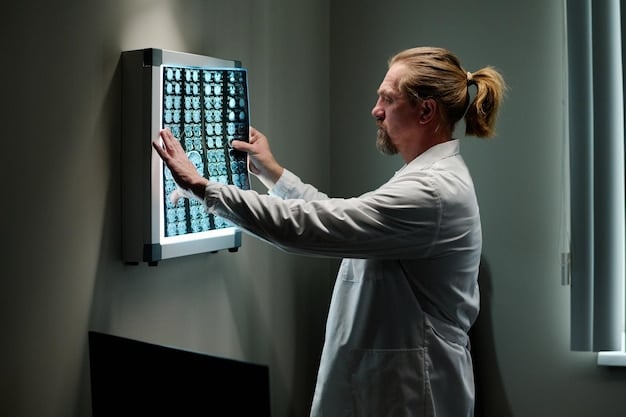Latest Breast Cancer Screening Recommendations 2025

The latest recommendations for breast cancer screening in 2025 emphasize a personalized approach, integrating age, risk factors, and evolving technologies to optimize early detection and improve patient outcomes.
Staying informed about the latest recommendations for breast cancer screening in 2025 is crucial for maintaining good health. These guidelines evolve as scientific understanding advances, offering improved strategies for early detection and personalized care.
The Evolving Landscape of Breast Cancer Screening
Breast cancer screening is a dynamic field, constantly refined by new research and technological advancements. What was considered standard a decade ago might not be the most effective approach today. In 2025, the emphasis shifts even further towards tailored screening protocols, moving beyond a one-size-fits-all model.
The goal remains consistent: to detect breast cancer at its earliest, most treatable stages. However, how we achieve this is becoming increasingly sophisticated, incorporating a deeper understanding of individual risk profiles and the benefits and limitations of various screening modalities.
Personalized Screening Approaches
Gone are the days when simply recommending annual mammograms for everyone above a certain age was sufficient. Current guidelines, and those anticipated for 2025, champion a personalized approach. This means considering a woman’s unique risk factors, including family history, genetic predispositions, breast density, and prior medical conditions.
- Risk Assessment Tools: Advanced tools are now common, integrating various data points to calculate an individual’s lifetime risk of developing breast cancer.
- Genetic Counseling: For those with significant family histories, genetic testing and counseling play a more prominent role in guiding screening decisions.
- Breast Density: The awareness and understanding of breast density’s impact on mammogram effectiveness are leading to more targeted supplementary screening for women with dense breasts.
This individualized strategy aims to optimize detection while minimizing over-screening and its associated harms, such as false positives and unnecessary biopsies. It empowers both patients and healthcare providers to make informed decisions based on the most current evidence.
Understanding your personal risk factors is the first step in navigating the complex world of breast cancer screening. Consulting with your healthcare provider to discuss your specific situation is always recommended to establish the most appropriate screening regimen for you.
Mammography: Still the Cornerstone, but with Enhancements
Despite new technologies emerging, mammography remains the primary screening tool for breast cancer due to its proven efficacy in reducing mortality. However, the technology itself continues to evolve, offering clearer images and better detection rates.
Digital mammography, which replaced traditional film, is now standard. In 2025, 3D mammography, also known as breast tomosynthesis, is increasingly becoming the preferred method. This advanced technique provides a more detailed, three-dimensional view of the breast, which helps detect smaller cancers and reduces the number of call-backs due to unclear images.
Key Developments in Mammography
- 3D Mammography (Tomosynthesis): This technology creates a series of thin images, similar to a CT scan, allowing radiologists to examine breast tissue layer by layer. This can be particularly beneficial for women with dense breasts, where traditional 2D mammograms may be less effective.
- AI Integration: Artificial intelligence is playing an increasingly vital role in mammography. AI algorithms can assist radiologists in reviewing images, identifying subtle abnormalities that might be missed by the human eye, and even prioritize studies that require immediate attention. This enhances diagnostic accuracy and efficiency.
- Lower Radiation Doses: Continuous improvements in technology are striving to reduce radiation exposure while maintaining image quality. Modern mammography machines are designed to deliver the lowest possible dose necessary for effective screening.
While mammography is highly effective, it’s not perfect. It can produce false positives, leading to anxiety and further testing. It can also produce false negatives, meaning a cancer is present but not detected. Recognizing these limitations is part of a comprehensive screening strategy.
For most women, regular mammograms, often starting at age 40 or 50 depending on guidelines and individual risk, continue to be the most critical component of their breast health routine. The improvements in mammographic technology mean this cornerstone is stronger than ever.
Beyond Mammography: Supplementary Screening Modalities
For certain individuals, particularly those at higher risk or with dense breast tissue, supplementary screening methods are increasingly recommended alongside mammography. These additional tools can provide a more comprehensive view and improve the chances of early detection.
The choice of supplementary screening depends on a complex interplay of factors, including breast density, genetic predisposition, family history, and personal preference. The goal is to maximize the detection rate while minimizing unnecessary procedures and patient anxiety.
Magnetic Resonance Imaging (MRI)
Breast MRI is a highly sensitive imaging technique that does not use radiation. It is typically reserved for women with a significantly elevated lifetime risk of breast cancer (e.g., those with strong genetic mutations like BRCA1/2, or a very strong family history). Because of its high sensitivity, it often detects cancers that mammograms might miss.
- High Sensitivity: MRI is particularly adept at finding invasive cancers, especially in dense breasts.
- No Radiation: A significant advantage for those who require frequent screening.
- Contrast Agent: Requires an intravenous contrast agent, which can have side effects in some individuals.
Ultrasound
Breast ultrasound is another non-radiation imaging technique often used as a supplementary tool for women with dense breasts, or to further evaluate an abnormality found on a mammogram or clinical exam. It’s particularly useful for distinguishing between fluid-filled cysts and solid masses.
While ultrasound can detect some cancers missed by mammography in dense breasts, it has a higher rate of false positives compared to MRI or mammography, underscoring the need for careful interpretation.
Molecular Breast Imaging (MBI) / Scintigraphy
MBI, also known as breast scintigraphy, is an emerging technology that uses a small amount of radioactive tracer and a special camera to detect metabolic activity in breast tissue. Cancer cells tend to be more metabolically active than normal cells, making them “light up” on an MBI scan. This technique is also particularly useful for women with dense breasts or those who cannot undergo MRI.
These supplementary methods are not replacements for mammography but rather complement it, creating a more robust screening protocol for those who stand to benefit most from them. Discussion with a healthcare provider is essential to determine if these additional screenings are appropriate for your individual circumstances.

Risk Factors and Personalized Screening Schedules
Understanding your individual risk factors is paramount in determining your optimal breast cancer screening schedule for 2025. The shift from age-based universal guidelines to a risk-adapted approach signifies a major leap forward in preventive medicine.
Not all women face the same risk of developing breast cancer. Factors like genetics, family history, lifestyle, and breast density play a significant role. A comprehensive risk assessment helps healthcare providers tailor screening recommendations, ensuring the right tests are performed at the right intervals for each individual.
Key Risk Factors to Consider
- Family History: Having a close relative (mother, sister, daughter) who had breast cancer, especially at a young age, significantly increases your risk.
- Genetic Mutations: Inherited mutations in genes like BRCA1 and BRCA2 are associated with a substantially higher lifetime risk of breast and ovarian cancers. Other genes, such as PALB2 and CHEK2, are also linked to increased risk.
- Breast Density: Women with dense breasts have a higher risk of breast cancer, and the density itself can make cancers harder to detect on a mammogram.
- Personal History: A personal history of certain benign breast conditions (e.g., atypical hyperplasia or lobular carcinoma in situ, LCIS) can elevate future breast cancer risk.
- Radiation Exposure: Therapeutic radiation to the chest at a young age can increase breast cancer risk later in life.
- Reproductive Factors: Early menstruation, late menopause, never having full-term pregnancy, or having a first full-term pregnancy after age 30 can slightly increase risk.
- Lifestyle Factors: Obesity, excessive alcohol consumption, and lack of physical activity are also identified as risk factors.
For women identified as high-risk, screening may begin at an earlier age (e.g., in their 30s) and might involve more frequent screenings or the addition of MRI to their annual mammograms. Conversely, women with an average or low risk may follow standard age-based recommendations.
It’s crucial to have an open conversation with your healthcare provider about your personal and family medical history to assess your individual risk accurately. This discussion forms the basis for a personalized screening plan designed to optimize early detection while minimizing unnecessary interventions.
Addressing Disparities and Enhancing Access
While advancements in breast cancer screening offer incredible promise, ensuring equitable access to these technologies and personalized care remains a critical challenge for 2025 and beyond. Disparities in screening rates and outcomes persist across various demographic groups, influenced by socioeconomic status, geographic location, and racial/ethnic background.
Efforts are increasingly focused on bridging these gaps, recognizing that early detection is only effective if it reaches all populations at risk. This involves not only technological solutions but also robust public health initiatives and policy changes.
Initiatives for Enhanced Access and Equity
- Community Outreach Programs: Tailored educational campaigns and mobile screening units are vital in reaching underserved communities, increasing awareness and reducing barriers to care.
- Telemedicine and Remote Consultations: Leveraging virtual platforms can expand access to genetic counseling and risk assessments for individuals in rural or underserved areas, ensuring they receive personalized recommendations without extensive travel.
- Affordability and Insurance Coverage: Advocacy for comprehensive insurance coverage for all recommended screening modalities, including supplementary ones for high-risk individuals, is crucial to remove financial barriers.
- Culturally Competent Care: Training healthcare providers to deliver culturally sensitive information and services can build trust and improve engagement within diverse communities.
- AI for Resource Allocation: AI can potentially optimize screening schedules and resource allocation in healthcare systems, ensuring that limited resources are directed where they are most needed.
The vision for breast cancer screening in 2025 is not just about having sophisticated tools, but about making sure these tools are accessible to everyone who needs them. Addressing health disparities is essential for realizing the full potential of early detection strategies and ultimately reducing the burden of breast cancer across all populations.
Continued collaboration among healthcare providers, policymakers, community organizations, and researchers is necessary to dismantle the systemic barriers that impede equitable access to life-saving screenings.

Emerging Technologies and Future Outlook
The field of breast cancer screening is exceptionally dynamic, with significant research and development focused on even newer technologies beyond those currently in wide use. The outlook for 2025 and beyond includes advancements that promise to make screening even more precise, less invasive, and potentially more accessible.
These emerging technologies aim to overcome current limitations, such as the challenges of detecting cancers in dense breasts, reducing false positives, and identifying aggressive cancers earlier. While some are still in research phases, others are moving closer to clinical application.
Promising Innovations on the Horizon
- Contrast-Enhanced Mammography (CEM): This technique combines traditional mammography with an intravenous contrast agent. Like MRI, it highlights areas of increased blood flow, which can indicate the presence of a tumor. CEM is being explored as an alternative to MRI for some patients, offering similar benefits at a lower cost and shorter exam time.
- Liquid Biopsies: This non-invasive method involves analyzing blood samples for circulating tumor DNA (ctDNA) or circulating tumor cells (CTCs). While primarily used for cancer monitoring and recurrence detection currently, vigorous research is underway to explore its potential for early cancer detection, including breast cancer.
- Thermal Imaging/Thermography: This technique measures heat patterns on the skin surface, as cancerous tumors often produce more heat than surrounding tissue. While not yet a standalone screening tool due to its limitations, ongoing research aims to refine its utility, potentially as an adjunctive method.
- Optical Imaging: Utilizes light to characterize breast tissue. Technologies like diffuse optical tomography (DOT) and photoacoustic tomography (PAT) are being investigated for their ability to distinguish between benign and malignant lesions without radiation.
- Advanced AI and Machine Learning: Further integration of AI will not only improve image interpretation but also aid in predicting individual risk trajectories, optimizing screening intervals, and personalizing treatment more effectively.
The future of breast cancer screening is likely to be characterized by an increasingly diverse array of tools, each with specific strengths. The “best” screening method will continue to be highly individualized, determined by a woman’s unique biological profile, risk factors, and evolving medical knowledge.
Ongoing research and clinical trials are essential to validate these emerging technologies and determine their optimal role within comprehensive screening strategies. The ultimate goal is a future where breast cancer is detected so early that it is virtually always curable, and screening is as safe and convenient as possible for all.
| Key Aspect | Brief Description |
|---|---|
| 🧬 Personalized Screening | Guidelines emphasize tailoring screening based on individual risk factors, genetics, and breast density. |
| 💡 Enhanced Mammography | 3D mammography (tomosynthesis) and AI integration are standard, improving detection and accuracy. |
| ➕ Supplementary Tools | MRI, ultrasound, and MBI are vital for high-risk women or those with dense breasts. |
| 🔬 Future Outlook | Emerging technologies like liquid biopsies and CEM hint at even more precise, non-invasive methods. |
Frequently Asked Questions
The recommended starting age for breast cancer screening in 2025 is becoming increasingly personalized. For average-risk women, guidelines generally suggest starting mammograms between ages 40 and 50. However, if you have specific risk factors like a strong family history or genetic predispositions, your doctor may recommend starting earlier, often in your 30s. A risk assessment consultation with your healthcare provider is crucial to determine your optimal starting age and screening frequency.
3D mammography, or breast tomosynthesis, is an advanced imaging technique that creates a detailed, three-dimensional view of the breast. It takes multiple X-ray images from different angles, which are then compiled into a 3D image. This is important because it allows radiologists to see through dense breast tissue more effectively, reducing overlapping tissue artifacts that can obscure cancers or lead to false alarms. It is becoming the standard for many screening centers in 2025 due to its improved detection rates and reduced recall rates compared to traditional 2D mammograms.
Supplementary screenings such as MRI or ultrasound are typically recommended for women at higher risk of breast cancer or those with dense breast tissue. High-risk factors include genetic mutations (e.g., BRCA1/2), a strong family history of breast cancer, or a history of certain high-risk benign breast conditions. For women with dense breasts, these additional tools can help detect cancers that might be hidden on a mammogram. Your doctor will assess your individual risk profile to determine if these additional tests are necessary.
While lifestyle changes primarily influence your overall breast cancer risk, they do not directly alter your screening recommendations in 2025 once you’ve reached screening age. Maintaining a healthy weight, limiting alcohol consumption, and engaging in regular physical activity are crucial for reducing your risk. However, regardless of your lifestyle, regular screening according to your personalized plan remains essential for early detection. Your healthcare provider will consider all risk factors, including lifestyle, when formulating your comprehensive breast health strategy.
Beyond 2025, we can anticipate more precise, less invasive, and highly personalized screening methods. Emerging technologies include contrast-enhanced mammography (CEM) as an alternative to MRI, and the further development of liquid biopsies for early detection. Advancements in artificial intelligence will continue to refine image interpretation and risk assessment. The goal is to develop highly sensitive and specific tools that can detect even the earliest and most aggressive cancers, making screening more effective and convenient for all individuals.
Conclusion
The landscape of breast cancer screening in 2025 reflects a clear shift towards precision and personalization. By integrating advanced imaging technologies, comprehensive risk assessments, and a deeper understanding of individual patient needs, the latest recommendations aim to improve early detection rates while minimizing unnecessary interventions. Staying informed and engaging in open discussions with your healthcare provider about your personal risk factors and the most appropriate screening regimen for you is more vital than ever. The future of breast health is one where early detection is not just effective, but also tailored, accessible, and continuously evolving to save more lives.





